 |
 |
 |
|
Day1; After an overnight flight to Santiago, Chile, I checked into a downtown hotel with the group and took a walk on my own into the city center during lunch time. I walked to the Catedral Metropolitana de Santiago. This cathedral in Santiago's Plaza de Armas was built between 1748 and 1800. Earlier cathedrals were destroyed by earthquakes. There were renovations under way in the plaza that prevented a better view. Crowds in downtown markets and restaurants rivaled or exceeded any I ever experienced in Manhattan, Chicago or San Francisco.
|
Day 2: La Moneda Palace: Office of the President. While I took this photo with our tour group in front of the Palace, an Australian walked up and said he wished the group would get out of the way because they were ruining his photo. I turned to him, smiled and said, "Yes, those bloody Americans spoil everything." He laughed and we had a nice chat including tips on best photo sites when touring Sydney.
|
Day 2: Changing of guard at La Moneda Palace. Note the female palace guard in the center. The president of Chile is Michelle Bachelet. I wonder if she feels safer knowing there are women in the palace guard detail.
|
 |
 |
 |
|
Day 2: Statute of Salvador Allende outside La Moneda Palace where he died (assasinated/committed suicide) in 1973. The likely participation of the CIA in his downfall/death is one of the darker manifestations of US-Chilean relations through the years.
|
Day 2: Northern Santiago and the mountains behind the smog. The US Embassy is in the foreground (short building with turret).
|
Day 2: Fish stand at the Mercado Central. It left me longing for Pike Place....and fresher looking fish.
|
 |
 |
 |
|
Day 2: Inside of the Catedral Metropolitana de Santiago
|
Day 2: Carabineros de Chile officer and his dog on Paseo Estado. Pickpocketing, purse snatching and muggings are a fact of life in Santiago. There is a heavy presence of carabineros in all of the tourist areas, many with dogs or mounted on horses. About 10 on motorcycles were stationed briefly outside our hotel in a staging area.
|
Day 2: Mounted Carabineros de Chile on Plaza de Armas
|
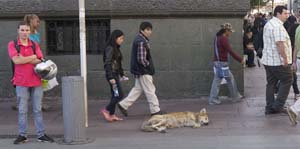 |
 |
 |
|
Day 2: Free roaming dogs are found practically on every corner, on sidewalks and sleeping in the streets. They live on garbage and offerings from passer bys. There is strong support by the population to leave them be every time a proposal comes up to control them. I wonder what they do for rabies control?
|
Day 2: Street performer. If you don't sing, act or sell food/crafts....there's always the golden buddha routine.
|
Day 2: Desperately seeking Southern celestial objects. Our group drove an hour North of Santiago to the research observatory of the Santiago Catholic University and got our first taste of viewing Southern objects through the sky glow of Santiago.
|
 |
 |
 |
|
Day 3: Looking East out of the plane on the trip from Santiago to La Serena. Valleys are cloud covered with the volcanic peaks in the Andes in the distance.
|
Day 3: Copper mine fly over near La Serena.
|
Day 3: Exiting our Airbus 320 on the tarmac in La Serena
|
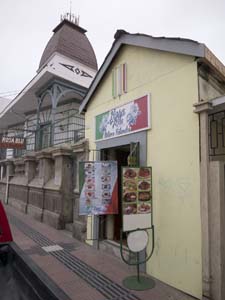 |
 |
 |
|
Day 3: Chile has an diverse mix of native, European and Asian populations. I found this eclectic restaurant serving Italian and Thai cuisine run by a very lovely family. I had great seafood pasta and espresso.
|
Day 3: The cathedral at La Serena
|
Day 3: Palm tree in infrared in La Serena
|
 |
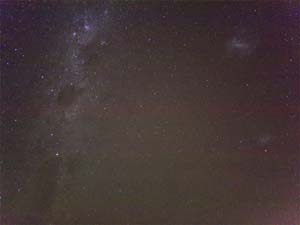 |
 |
|
Day 3: Iglesia Santo Domingo in La Serena
|
Day 3: A quick snapshot from the Collowara observatory showing the Southern Cross, the Coal Sac and Large Magellanic and Small Magellanic clouds
|
Day 3: Our group observing at the Collowara observatory
|
 |
 |
 |
|
Day 4: Sunrise at La Serena
|
Day 4: On the road out of the Elqui Valley to Cerro Telolo
|
Day 4: Cerro Telolo Inter-American Observatory at 2200 meters (about 7,000 ft). This building housing the 1.5 meter Cassegrain telescope was dedicated in 1967 and is funded by Chile, USA, Canada and other countries and universities in North and South America.
|
 |
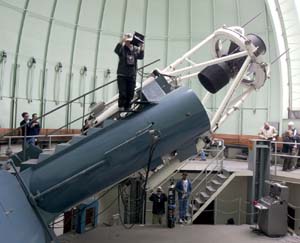 |
 |
|
Day 4: 1.5 meter Cassegrain telescope. This was originally designed for spectroscopy work and made some of the key observations on supernova SN1986A.
|
Day 4: Our group was told to keep climbing stairs, and Scott Gainey in our group took the directions literally and climbed the stairs onto the counterweight assembly of the equatorial mount.
|
Day 4: Our group exams detectors, control panel, and poses for group photos on the deck.
|
 |
 |
 |
|
Day 4: The 1.5 M Cassegrain telescope is now doing infrared imaging as part a project identifying and characterizing extra-solar system planets. This is a closeup of the Canadian infrared detector/imaging system .
|
Day 4: Detail of the spectrograph sitting on its stand while the IR detector is in use
|
Day 4: Gary Spears from Spears Travel, Bob Naeye (editor of Sky and Telescope Magazine), and our local guide, Ornan Araya, are standing in front of the dome for the 4 Meter Victor M. Blanco telescope.
|
 |
 |
 |
|
Day 4: Kodura Flores orients us to the control room for the 4 Meter telescope.
|
Day 4: Victor M. Blanco 4 Meter telescope. Tour groups aren't normally allowed in the dome, so we were very lucky to be in a Sky and Telescope tour. The telescope is currently engaged in a 5-year Dark Energy Survey using a 570-megapixel camera (Dark energy camera - DECam) built by Fermilab that can image more than 100,000 galaxies in a single field up to 8 billion light years away.
|
Day 4: Doors were opened on the dome so our group could get good view of the grounds and surroundings including the many small remotely operated domes that are run by universities throughout the americas.
|
 |
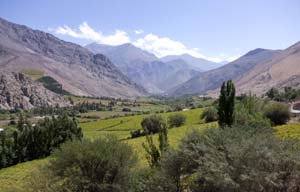 |
 |
|
Day 4: Kodura Flores discussing the telescope and DECam. He has been at the observatory since it began operations in the 1970's.
|
Day 5: After an incredible evening of viewing on 25 inch Dobsonian and 16 inch SCT in a very dark site, we took a bus through the Elqui Valley, a major grape, citrus and avacado growing area. The area is the largest producer of Pisco in Chile and produces many of Chile's wines.
|
Day 5: Muscat grape vinyards at Pisquera ABA, one of the smaller, family owned Pisco producers. Pisco is a distillate (40% alcohol) of wine that is popular in Chile and Peru.
|
 |
 |
 |
|
Day 5: Detail of Muscat grapes ready for harvest.
|
Alejandro Aguirre stands in front of a copper still pot and explains the distillation process to derive alcohol with aromatic properties of the grapes as well as the short aging process. Our group tasted a few Pisco cocktail samples at the end of the tour and went merrily along our way.
|
Day 5: Infrared detail of monkey puzzle tree (Araucaria araucana) native to Chile and other countries .
|
 |
 |
 |
|
Day 5: The Elqui River is fed by runoff from snow fields in the Western Andes and is the key to the fertility of the Elqui Valley. Incas after they invaded the Valley were the first to develop irrigation channels to allow cultivation on the terraced sides of the valley.
|
Day 5: Valley and terraced vineyards on the left contrast with dark green terraced Haas avacodos on the right.
|
Day 5: Infrared photo of Iglesia Nuestra Senora del Rosario in Pisco Elqui.
|
 |
 |
 |
|
Day 5: Infrared photo of palm tree in Pisco Elqui.
|
Day 5: Infrared photo of view looking farther up the Elqui Valley
|
Day 5: Minimarket and Panaderia in Pisco Elqui
|
 |
 |
 |
|
Day 5: Terraced fields and valley near Monte Grande.
|
Day 5: Statue of Nobel Laureate Gabriela Mistral and terraced vineyards in Monte Grande.
|
Day 7: Atacama plateau and Andes in the afternoon. Infrared photo
|
 |
 |
 |
|
Day 7: Llamas in the Valle Arcois (Rainbow Valley)
|
Day 7: Brush, Boulders and Sky (Valle Arcois) (Infrared)
|
|
 |
 |
 |
|
Day 7: Salt flat, Sand dune and sky in Valle de la Luna (Valley of the Moon)
|
Day 7: Valle de la Luna
|
Day 7: Valle de la Muerte (Valley of the Dead)
|
 |
 |
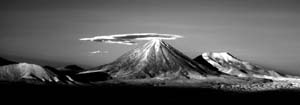 |
|
Day 7: Stratovolcano Licanabur in the afternoon (Infrared)
|
Day 7: Stratovolcano Licanabur at sunset
|
Stratovolcano Licanabur at sunset (infrared)
|
 |
 |
 |
|
Day 8: Geothermal plumes at El Tatio before dawn. We left the hotels at 5:45 AM for the 1.5 hour drive into the Andes.
|
Day 8: Geyser at Tatio. Most of our group had been to Yellowstone National Park which has much more impressive geysers. However, El Tatio has the highest geysers in the world at 13,776 feet above sea level and among the largest geysers in the Southern hemisphere
|
Day 8: As we were getting ready to leave El Tatio after a fantastic breakfast, a group of vicuņa walked onto the fields (You won't see that at Yellowstone.)
|
 |
 |
 |
|
Day 8: Vicuņa grazing along the access road to El Tatio. Vicuņa normally are found above 3,500 meters (11,480 feet).
|
Day 8: View of the Altiplano (Andean plateau) looking into Bolivia. The Altiplano is one of the largest high plateaus in the world and extends from Peru and into Bolivia and North Chile. This photo is taken at the altitude of 13,991 feet.
|
Day 8: Cardon cactus on our drive through the foothills of the Andes back to San Pedro de Atacama.
|
 |
 |
|
|
Day 8: Detail of Cardon cactus in infrared.
|
Day 8: Afternoon view of the foothills of the Andes at the altitude of 10,824 feet.
|